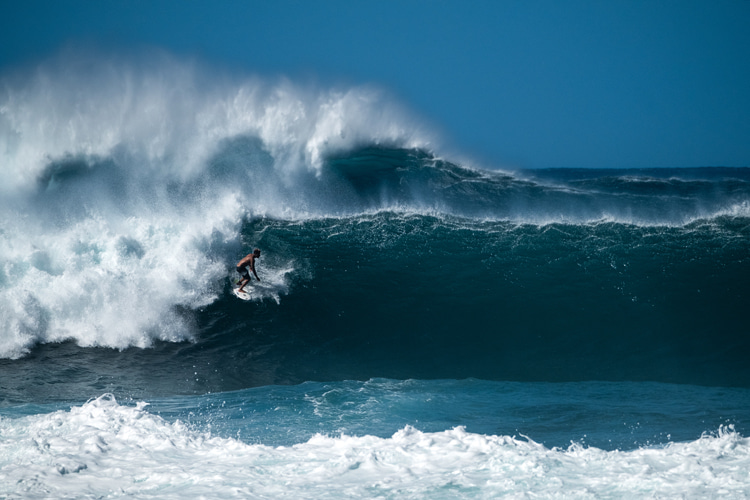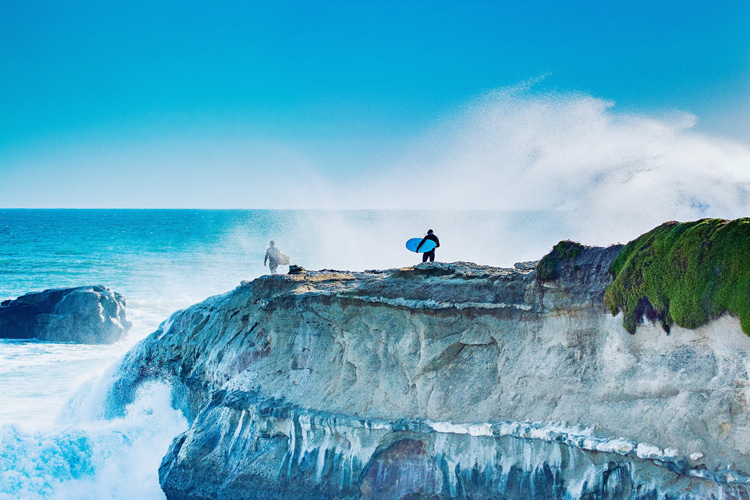Exploring and testing our limits is part of human nature. We're always doing it in our daily lives, but also when challenged by the power of the ocean.
If there's one sport with a nearly endless variety of challenges, that is surfing. And there is nothing quite getting uncomfortable in the ocean.
From the day you get a surfboard to the water for the first time to the moment you paddle for the 100-foot wave, there's an almost infinite list of missions you're confronted with.
The fear of deep water, also known as thalassophobia, where surfing usually takes place, is actually one of the first tests some people need to overcome.
Although it might sound absurd to many experienced surfers, being comfortable in the ocean is not something we are all born with.
So, on our journey to becoming accomplished wave riders, there are several steps we need to consolidate to build a solid structure of confidence and trust in our skills and survival instinct.
Confidence is a very tall cake with many layers of success and failure, joy, frustration, fear, and pain.
You cannot learn how to cope with a three-wave hold-down if you've never had to go through it.
You will never know how big it is too much when it comes to wave height if you've never been exposed to a large swell.
And how close to a coral reef or a rocky headland can you surf? Is it worth the risk? When does your brain tell you to stop?
The exploration of the human limits varies from person to person.
And this lifelong quest is constantly changing within ourselves.
Some days, we feel brave and uber-confident; some days, we take it conservatively and play it safe.
Young people tend to take more risks than older folks. And that's part of growth.
But when it comes to surfing, how do we know our limits?
Do we ever realize we've reached our pain point? When are we really about to enter living-on-the-edge territory?
Remember that there are many variables of danger involved in surfing. Here are the main threats:
- Wave height;
- Weather phenomena;
- Rip currents;
- Shoreline features;
- Coral and rocky bottoms;
- Water temperature;
- Crowd;
- Water pollution;
- Watercraft;
- Marine creatures;
It wouldn't obviously make sense to consider that surfing is not a safe sport. It is.
However, the more you push your limits, the finer the line of finding the balance between taking risks, getting rewarded, and staying safe will be.
There are ways to improve our knowledge of ourselves and the limits we want to draw around us every time we paddle out.
The more the following items are ticked off the checklist, the more you will be comfortable exploring the boundaries of the extreme.

Physical Fitness
Maintain a good level of physical fitness. That's paramount, really.
Surfing can be physically demanding, and being in shape helps you to handle challenging situations more effectively, reducing the risk of injury.
If you're in shape, you're better prepared to get pounded, to wipe out, and to duck-dive an incoming set.
And it's also a great confidence booster knowing that you're feeling good paddling around in the lineup and getting fast into waves.
Mental Preparation
Develop mental resilience. Surfing, like many sports, requires a strong mental attitude.
Explore the psychological aspects of surfing, including managing fear and stress, maintaining focus, making quick decisions, and how understanding these can help recognize one's limits.
Mental preparedness is just as important as physical preparedness.
There are many ways to do it - meditation and mind surfing could help.
Skill Assessment
Regularly evaluate your surfing skills - that's critical.
Understanding your abilities helps you choose waves that challenge you without overwhelming you.
This self-awareness is key to taking calculated risks.
If you're not ready for a backhand point break or your take-off is not quick enough for a fast, steep, barreling wave, practice a bit more in less challenging conditions before moving forward.
Knowledge of the Environment
Familiarize yourself with the surfing environment.
This includes understanding the local wave patterns, tides, currents, and weather conditions.
Knowing these factors allows you to anticipate and navigate potential risks more effectively.
The more information you have, the more options available in case you're struggling with any of the dangers listed above.
Use the Right Equipment
Always use suitable equipment.
It includes a surfboard appropriate for your skill level and the conditions and other safety gear like a leash, wetsuit, and, if necessary, a life vest.
In big wave surfing scenarios, inflatable life vests are mandatory.
The choice to not use them is not a sign of bravado but a sign of disrespect for yourself, your family, and those who might need to save your life.
Listen to Your Body
Pay attention to your body's signals.
If you're feeling tired, unwell, cold, or if there's any physical discomfort, it's important to acknowledge these signs and possibly take a break.
Also, if your stress levels and fear go beyond the healthy, bearable stage, do not hesitate to paddle in.
Surfing is not meant to be uncomfortable and unpleasant.
Respect the Ocean
Always have respect for the ocean and its unpredictable, raw nature.
Respecting its power helps in making safer choices.
Whatever you're into, remember that the ocean shows no mercy and will always win.
Where possible, surf with others. Not only can this be more enjoyable, but it also means there are people to assist if something goes wrong.
Words by Luís MP | Founder of SurferToday.com
